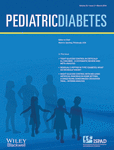Children followed in the TEDDY study are diagnosed with type 1 diabetes at an early stage of disease
Abstract
Objective
The Environmental Determinants of Diabetes in the Young (TEDDY) study is designed to identify environmental exposures triggering islet autoimmunity and type 1 diabetes (T1D) in genetically high-risk children. We describe the first 100 participants diagnosed with T1D, hypothesizing that (i) they are diagnosed at an early stage of disease, (ii) a high proportion are diagnosed by an oral glucose tolerance test (OGTT), and (iii) risk for early T1D is related to country, population, human leukocyte antigen (HLA)-genotypes and immunological markers.
Methods
Autoantibodies to glutamic acid decarboxylase (GADA), insulinoma-associated protein 2 (IA-2) and insulin (IAA) were analyzed from 3 months of age in children with genetic risk. Symptoms and laboratory values at diagnosis were obtained and reviewed for ADA criteria.
Results
The first 100 children to develop T1D, 33 first-degree relatives (FDRs), with a median age 2.3 yr (0.69–6.27), were diagnosed between September 2005 and November 2011. Although young, 36% had no symptoms and ketoacidosis was rare (8%). An OGTT diagnosed 9/30 (30%) children above 3 yr of age but only 4/70 (5.7%) below the age of 3 yr. FDRs had higher cumulative incidence than children from the general population (p < 0.0001). Appearance of all three autoantibodies at seroconversion was associated with the most rapid development of T1D (HR = 4.52, p = 0.014), followed by the combination of GADA and IAA (HR = 2.82, p < 0.0001).
Conclusions
Close follow-up of children with genetic risk enables early detection of T1D. Risk factors for rapid development of diabetes in this young population were FDR status and initial positivity for GADA, IA-2, and IAA or a combination of GADA and IAA.




